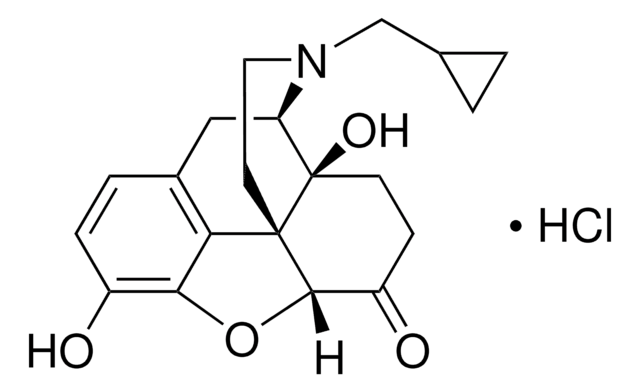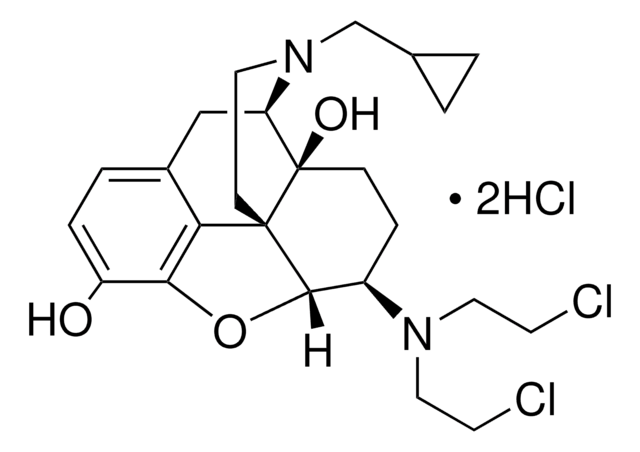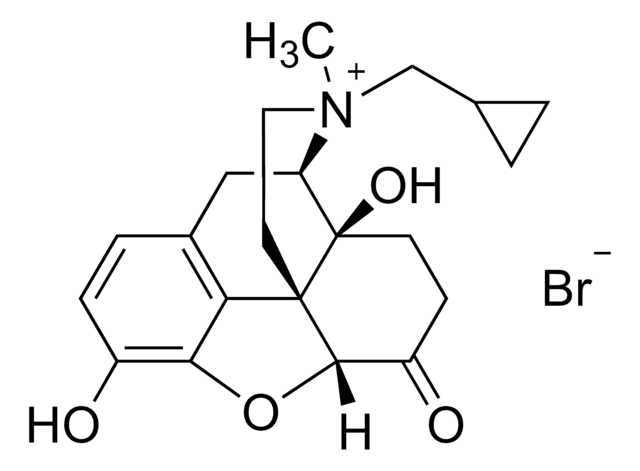N3136
Naltrexone hydrochloride
≥99% (HPLC), powder, opioid receptor antagonist
Synonym(s):
Naltrexone HCl
About This Item
Recommended Products
product name
Naltrexone hydrochloride,
form
powder
originator
Novartis
storage temp.
2-8°C
SMILES string
Cl.Oc1ccc2C[C@H]3N(CC[C@@]45[C@@H](Oc1c24)C(=O)CC[C@@]35O)CC6CC6
InChI
1S/C20H23NO4.ClH/c22-13-4-3-12-9-15-20(24)6-5-14(23)18-19(20,16(12)17(13)25-18)7-8-21(15)10-11-1-2-11;/h3-4,11,15,18,22,24H,1-2,5-10H2;1H/t15-,18+,19+,20-;/m1./s1
InChI key
RHBRMCOKKKZVRY-ITLPAZOVSA-N
Gene Information
human ... OPRD1(4985) , OPRK1(4986) , OPRM1(4988) , OPRS1(10280)
Looking for similar products? Visit Product Comparison Guide
Application
- as an opioid antagonist, to analyse its effect on ethanol preference using Caenorhabditis elegans as a model
- to determine its effectiveness in reducing the preference for substance of abuse (SOA) like nicotine and cocaine using Caenorhabditis elegans as a model
- in the preparation of combinatorial drug, PXT3003 for treating Charcot-Marie-Tooth disease 1A (CMT1A) transgenic rat model Pmp22
Biochem/physiol Actions
Features and Benefits
Signal Word
Warning
Hazard Statements
Precautionary Statements
Hazard Classifications
Acute Tox. 4 Oral
Storage Class Code
11 - Combustible Solids
WGK
WGK 3
Flash Point(F)
Not applicable
Flash Point(C)
Not applicable
Personal Protective Equipment
Regulatory Listings
Regulatory Listings are mainly provided for chemical products. Only limited information can be provided here for non-chemical products. No entry means none of the components are listed. It is the user’s obligation to ensure the safe and legal use of the product.
JAN Code
N3136-VAR:
N3136-250MG:
N3136-BULK:
N3136-1G:
N3136-100MG:
N3136-25MG:
Certificates of Analysis (COA)
Search for Certificates of Analysis (COA) by entering the products Lot/Batch Number. Lot and Batch Numbers can be found on a product’s label following the words ‘Lot’ or ‘Batch’.
Already Own This Product?
Find documentation for the products that you have recently purchased in the Document Library.
Customers Also Viewed
Our team of scientists has experience in all areas of research including Life Science, Material Science, Chemical Synthesis, Chromatography, Analytical and many others.
Contact Technical Service











![[Met5]Enkephalin acetate salt hydrate ≥95.0% (HPLC), powder](/deepweb/assets/sigmaaldrich/product/structures/158/699/80b4b65b-7e48-49a2-ba61-4433cf1f375c/640/80b4b65b-7e48-49a2-ba61-4433cf1f375c.png)
